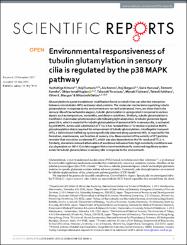| dc.contributor.author | Kimura, Yoshishige | |
| dc.contributor.author | Tsutsumi, Koji | |
| dc.contributor.author | Konno, Alu | |
| dc.contributor.author | Ikegami, Koji | |
| dc.contributor.author | Hameed, Saira | |
| dc.contributor.author | Kaneko, Tomomi | |
| dc.contributor.author | Kaplan, Oktay Ismail | |
| dc.contributor.author | Teramoto, Takayuki | |
| dc.contributor.author | Fujiwara, Manabi | |
| dc.contributor.author | Ishihara, Takeshi | |
| dc.contributor.author | Blacque, Oliver E. | |
| dc.contributor.author | Setou, Mitsutoshi | |
| dc.date.accessioned | 2019-06-27T08:20:46Z | |
| dc.date.available | 2019-06-27T08:20:46Z | |
| dc.date.issued | 2018 | en_US |
| dc.identifier.citation | SCIENTIFIC REPORTS Volume: 8 Article Number: 8392 DOI: 10.1038/s41598-018-26694-w | en_US |
| dc.identifier.issn | 2045-2322 | |
| dc.identifier.other | Accession Number: WOS:000433538800019 | |
| dc.identifier.other | PubMed ID: 29849065 | |
| dc.identifier.uri | http://acikerisim.agu.edu.tr/xmlui/handle/20.500.12573/41 | |
| dc.description.abstract | Glutamylation is a post-translational modification found on tubulin that can alter the interaction between microtubules (MTs) and associated proteins. The molecular mechanisms regulating tubulin glutamylation in response to the environment are not well understood. Here, we show that in the sensory cilia of Caenorhabditis elegans, tubulin glutamylation is upregulated in response to various signals such as temperature, osmolality, and dietary conditions. Similarly, tubulin glutamylation is modified in mammalian photoreceptor cells following light adaptation. A tubulin glutamate ligase gene ttll-4, which is essential for tubulin glutamylation of axonemal MTs in sensory cilia, is activated by p38 MAPK. Amino acid substitution of TTLL-4 has revealed that a Thr residue (a putative MAPKphosphorylation site) is required for enhancement of tubulin glutamylation. Intraflagellar transport (IFT), a bidirectional trafficking system specifically observed along axonemal MTs, is required for the formation, maintenance, and function of sensory cilia. Measurement of the velocity of IFT particles revealed that starvation accelerates IFT, which was also dependent on the Thr residue of TTLL-4. Similarly, starvation-induced attenuation of avoidance behaviour from high osmolality conditions was also dependent on ttll-4. Our data suggest that a novel evolutionarily conserved regulatory system exists for tubulin glutamylation in sensory cilia in response to the environment. | en_US |
| dc.description.sponsorship | National Bio-Resource Project of the MEXT, Japan National Center for Research Resources, National Institutes of Health (NIH) JSPS KAKENHI 25116712 -25293044 -25440082 -12J06986 MEXT Project for Creation of Research Platforms and Sharing of Advanced Research Infrastructure MEXT JASSO Otsuka Toshimi Foundation Takeda Science Foundation | |
| dc.language.iso | eng | en_US |
| dc.publisher | NATURE PUBLISHING GROUP, MACMILLAN BUILDING, 4 CRINAN ST, LONDON N1 9XW, ENGLAND | en_US |
| dc.rights | info:eu-repo/semantics/openAccess | en_US |
| dc.subject | NEMATODE CAENORHABDITIS-ELEGANS | en_US |
| dc.subject | INTRAFLAGELLAR TRANSPORT MOTORS | en_US |
| dc.subject | C. ELEGANS | en_US |
| dc.subject | VERTEBRATE PHOTORECEPTORS | en_US |
| dc.subject | NEURONS | en_US |
| dc.subject | PROTEIN | en_US |
| dc.subject | POLYGLUTAMYLATION | en_US |
| dc.subject | MECHANISM | en_US |
| dc.subject | ENZYMES | en_US |
| dc.subject | IDENTIFICATION | en_US |
| dc.title | Environmental responsiveness of tubulin glutamylation in sensory cilia is regulated by the p38 MAPK pathway | en_US |
| dc.type | article | en_US |
| dc.contributor.department | AGÜ, Yaşam ve Doğa Bilimleri Fakültesi, Biyomühendislik Bölümü | en_US |
| dc.contributor.institutionauthor | | |
| dc.relation.publicationcategory | Makale - Uluslararası Hakemli Dergi - Kurum Öğretim Elemanı | en_US |


















